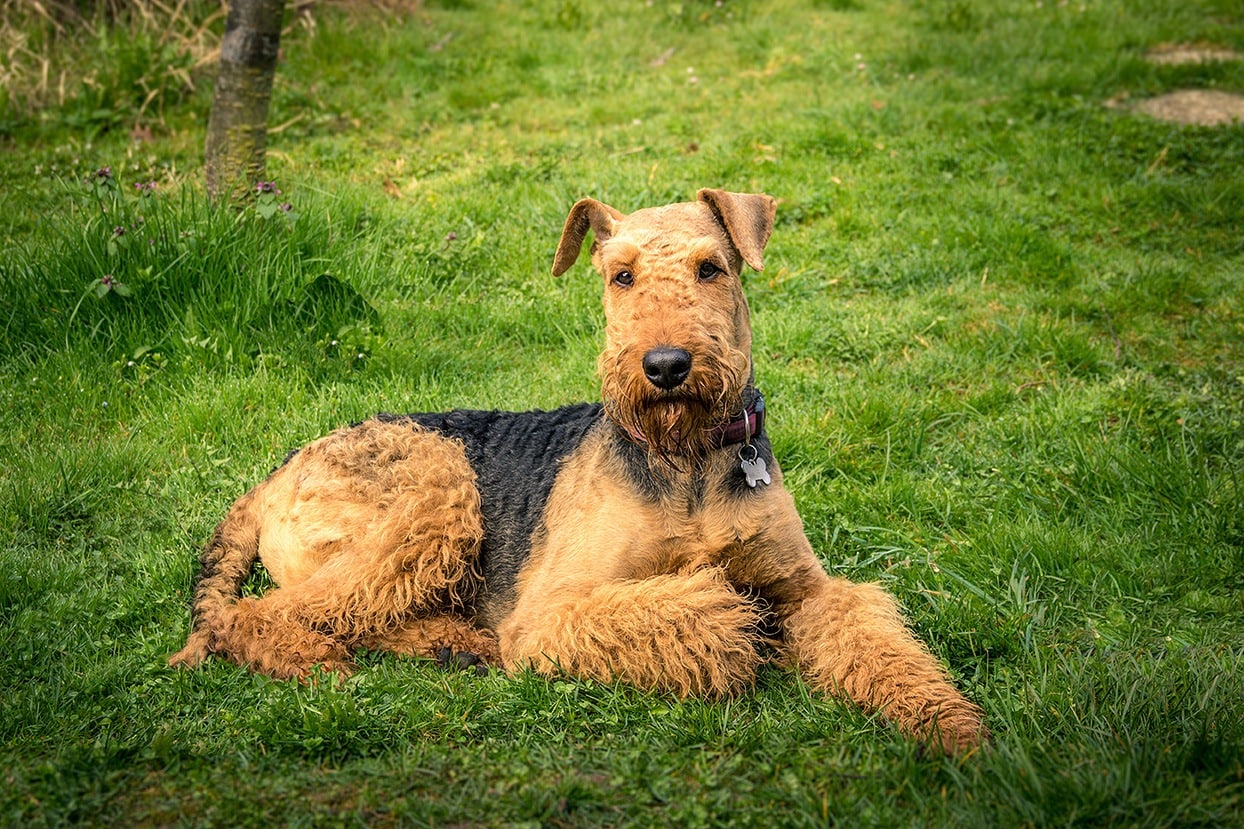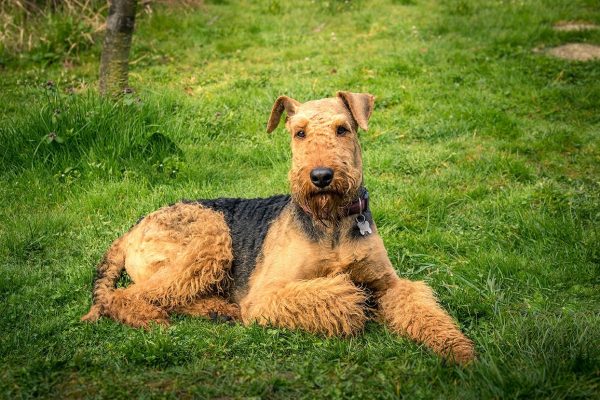The Airedale Terrier is a friendly and devoted dog known for its intelligence, obedience, and love of people. This breed is perfect for families who want a dog that will be affectionate and loyal. The Airedale Terrier is an easy dog to train and is known for being extremely responsive to positive reinforcement techniques. An Airedale Terrier makes the perfect pet for an active and sporty owner who provides them with sufficient physical and mental daily stimulation.
Airedales were created specifically to hunt vermin of all sizes and shapes. Unchecked, these predatory skills make Airedales potentially dangerous to other small animals in your home. When these agile dogs are trained to curb their natural hunting instinct, they are good with children, other pets, and livestock and are considered to be one of the most versatile dogs.
Throughout their history, Airedales have been used for a variety of purposes, including hunting, tracking, watchdogs, and search and rescue work. Read on for the fascinating story of how this breed came to be!
Originating Breeds
Airedales have been developed by crossing the old English rough-coated Black and Tan Terrier and various terriers with another British breed, the Otterhound. Let’s take a closer look at two of these ancestors.
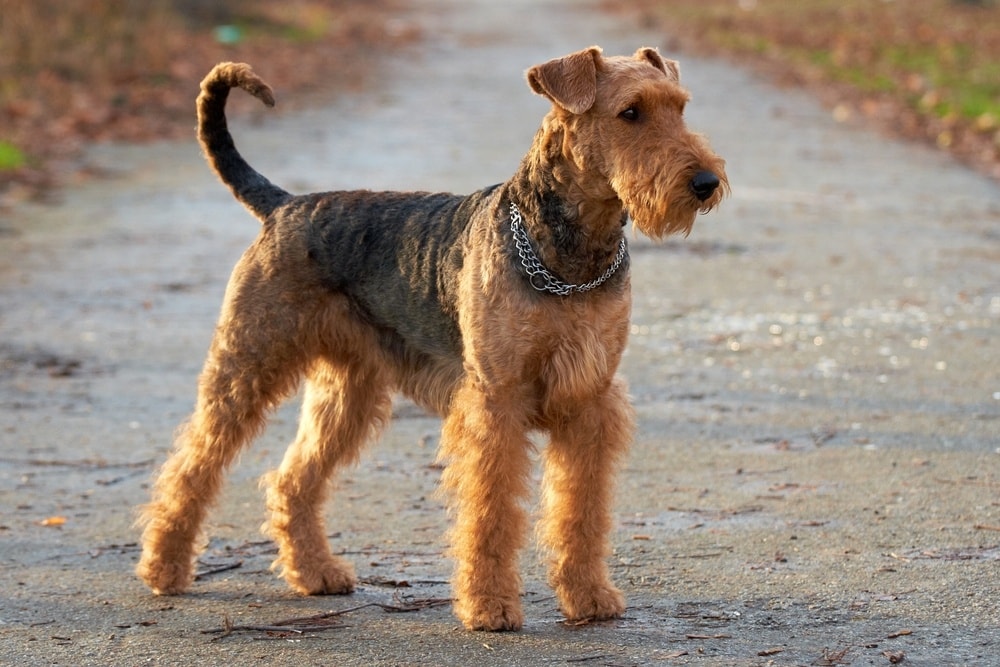
Otterhounds
Otterhounds are large, rough-coated hounds with imposing heads. With long striding steps, it has great strength, and a strong body, and was originally bred for hunting. As a result, it is capable of performing prolonged hard work. With a combination of oily, rough, double coat, and strong webbed feet, Otterhounds hunt both on land and in water. Using their keen sense of smell, they can track quarry for more than 3 days in the mud and water.
From the Otterhound, the Airedale inherited its rather amphibious traits. The Otterhound’s job description included hunting rats and otters in Yorkshire streams and rivers. This shaggy-haired ancestor not only contributed size and weight to the Airedale but also passed on to them their keen sense of smell and a love of water.
Black and Tan Terrier
Although the Otterhound still exists today as a breed, not so for the Black and Tan Terrier. Also, called the Broken Coated Working Terrier, the Black and Tan Terrier was one of the earliest breeds of terriers. Even though it is now extinct, it is thought to have been the ancestor of all modern Fell Terriers, the Welsh Terrier, and the Airedale Terrier. This was a much smaller dog than the modern Otterhound and today’s Airedales, weighing in at a maximum weight of 20 pounds. Unfortunately, this is as far as we can go with Airedale parentage, as the other terriers mixed into the Black and Tan and Otterhound bloodlines are not named.
The Mid-1800s: A Working Terrier
In the mid 19th Century, Airedales, like many terriers, were developed by working men who didn’t have the means, leisure, or space to feed and keep numerous specialized dogs. To meet their various needs and space requirements the Airedale was therefore designed to be a multipurpose dog, rather than one that was bred to excel in a single aspect. In addition to killing mice and rats, Airedales could even track and kill larger creatures such as deer, watch over family property, help in gun shooting by retrieving wildlife such as hares and pigeons that had been shot, and even herd home the stray sheep and cows. Although Airedales were too large to delve into animal burrows or “go to ground”, they were just as lively, vibrant, and fearless as other smaller terrier counterparts.
“King of Terriers”
Airedales became known as the “King of Terriers” due to their large size and versatility as working dogs. It is partly because this breed is capable of completing so many different tasks that it earned its royal title. The Airedale is also the largest of the terrier breeds. They stand about 22–24 inches tall and weigh 50–80 pounds. It’s no wonder that this royally-nick-named breed is also one of the most popular types of dog breeds in the world.
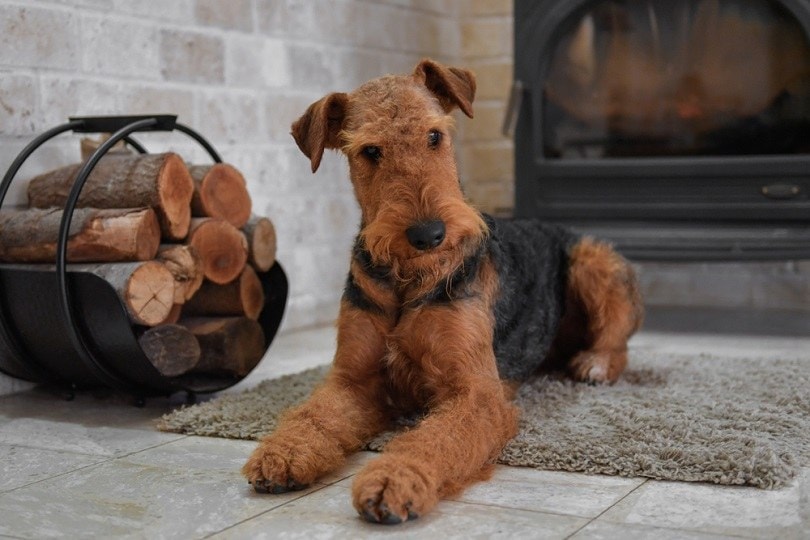
Poaching
Due to the Airedale’s versatility, this breed was a popular choice for poachers who slipped onto Victorian estates to steal game that was restricted to use by the aristocracy. Poaching was a common problem in Victorian England as many people were struggling to make a living. The government tried to crack down on poaching, but it was difficult to enforce the law since the countryside was so large. Poachers often used guns to kill birds, deer, and other animals, and they often sold the meat illegally. The government offered rewards for information about poachers, but it was difficult to catch them.
In the 1800s, poaching was a serious crime in England. People who poached game animals faced harsh penalties, such as imprisonment or fines. Poachers were often viewed as criminals, and they were often portrayed in negative ways in the media. However, some people argue that poaching was actually a way of life for many people in rural England and that the penalties for poaching were too harsh.
River-rat Hunting
Airedale Terriers were also used in Victorian England to hunt river rats. The dogs would flush out the rats from their hiding places and then kill them with their sharp teeth. Then as now, wild rats were considered a nuisance because they would steal food from houses and farmers, spread disease, and damage crops. The Airedale Terrier was bred specifically to be an excellent hunter and tracker.
Its intelligence, strength, determination, and agility make it an ideal dog for this type of hunting. In Victorian times, factory and mill workers organized river-rat hunts on Saturdays. It was not uncommon for the men to wager a week’s wages on the dog they thought would find the rat holes on the riverbank. Once a ferret flushed the rat out, the dog would chase its occupant through the water until it closed its jaws around the fleeing rodent. It was common for the “King of Terriers” to be victorious in these competitions, which only added to their popularity as a working breed.
The Late 1800s: Local Exhibitions & Naming
In the late 1800s, dog shows throughout England did not often feature the Airedale due to its modest origins. During local Yorkshire shows, the Airedale was exhibited under various titles, such as a “Broken-Haired Terrier,” “Working Terrier,” or “Waterside Terrier.” One prominent breeder suggested giving the breed a more formal name, the Bingley Terrier. This suggestion was generally rejected in order not to give unfair recognition to the corresponding Yorkshire city.
Eventually, Airedale was the name chosen for this sturdy terrier, in honor of the winding River Aire and its valley, called a dale. Airedale Terriers were officially named in 1879 by breed fanciers, and by 1886, the Kennel Club in England had approved the name.
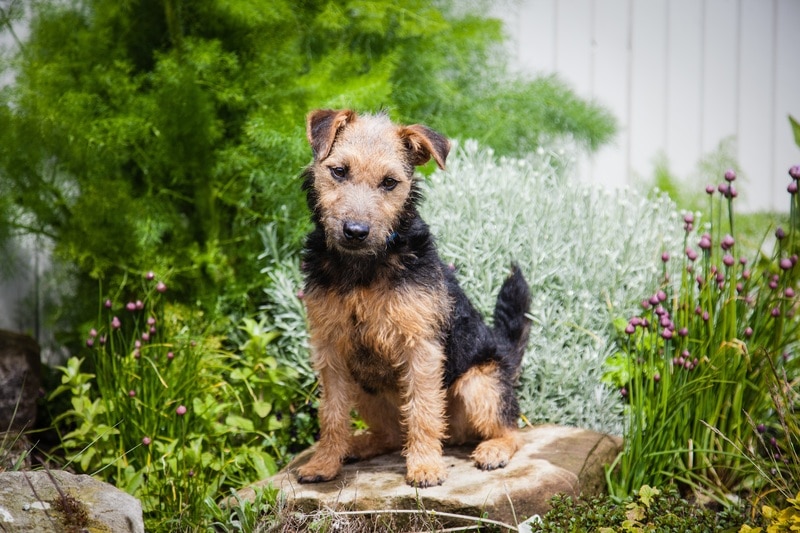
Early 20th Century: German Police Dog
During the 1890s, Germany was testing the idea of a police dog when the first Airedale was imported there. In addition to being loyal and reliable, they were also courageous and protective when needed. The Airedales convenient size, weather-resistant coat, and excellence at tracking made them ideal for police work. During the Boxer Rebellion in China in 1900, German Airedales were used to provide security, deliver messages, and deliver ammunition. The stage was set for the Airedale to become a highly valued military dog in Germany during World War I.
Pre WW1: Breeding “War Dogs”
As the Victorian era drew to a close, Colonel Edwin Richardson became increasingly interested in the use of war dogs by ancient Greeks and Romans. As a result, he was sought out internationally to provide dogs for that purpose. He brought together a mix of various breeds such as Collies, Bloodhounds, and Airedales. These dogs were sent to Russia, Turkey, and India.
With Airedales and other sheepdog breeds, Richardson started the British War Dog School in 1910. Richardson’s dogs would go on to play a significant role in the trenches of the Great War. Although it took time for the British military to recognize their value, the Germans figured it out much more quickly.
1914–1918: The Great War
Airedales were the top military dogs in World War I as watchdogs, couriers, bomb detectors, and dogs that searched for wounded soldiers, but their native Britain did not immediately understand their utility in times of war. Along with other German breeds like the Doberman Pinscher, German Shepherd Dog, and Rottweiler, Airedales made major contributions to the German war effort. It was an ironic twist was having such a distinctly British breed regarded as the ultimate German war dog.
However, British soldiers soon discovered the amazing resource they had right under their noses as the war went on. By the war’s end, many Airedales had been sent to the front in WWI on the British side, and more than 2,000 of these dogs were provided by Col. Edwin Richardson.

Bravery in War
Jack’s story is one of the most dramatic examples of the tenacity and sheer pluck of these wartime Airedales. Jack was one of the dogs sent to war on the British side by Col. Edwin Richardson. In the face of mortars and gunfire, this brave dog ran a half-mile. His jaw and front leg were shattered when he arrived at his destination. When the critical message he was carrying was removed from his collar, he died instantly. Jack was later honored for having given valor in the presence of the enemy and awarded the Victoria Cross, which is the highest honor in the British military.
Popularity After the War
Stories about Airedales like Jack caught the public’s attention, resulting in the breed’s popularity skyrocketing. The Airedale Terrier began to be appreciated by a wealthier class of dog owners, among them Madeleine Astor, whose husband the American tycoon John Jacob Astor IV, and Airedale “Kitty”, both perished on the Titanic.
The Terrier of Presidents
Airedales were owned by four US presidents, including Warren Harding. Laddie Boy, a 6-month-old puppy, was brought home by the 29th president immediately after his inauguration in 1921. The terrier received reams of press coverage and created the modern tradition of news stories covering White House pets. In recognition of Laddie’s popularity, Hardgin produced a thousand miniature bronze statues of Laddie and distributed them to supporters. These statuettes are still highly sought after by collectors of political memorabilia.
Conclusion
In conclusion, the Airedale was initially bred as a versatile hunting and working dog, became a brave and indomitable war dog, and eventually became the canine of choice for socialites and presidents. Today, Airedale Terriers are an excellent choice for a family pet because of their friendly nature, intelligence, and strength.
If you are interested in adding an Airedale to your household, be sure to do your research and find a reputable breeder to ensure you get a healthy and well-socialized dog and prepare to give your dog plenty of exercise and training.
See also:
- Are Airedales Aggressive? Important Facts for Owners
- Airedale Terrier Pros & Cons: What To Consider Before Bringing One Home
Featured Image Credit: Lumia Studio, Shutterstock

